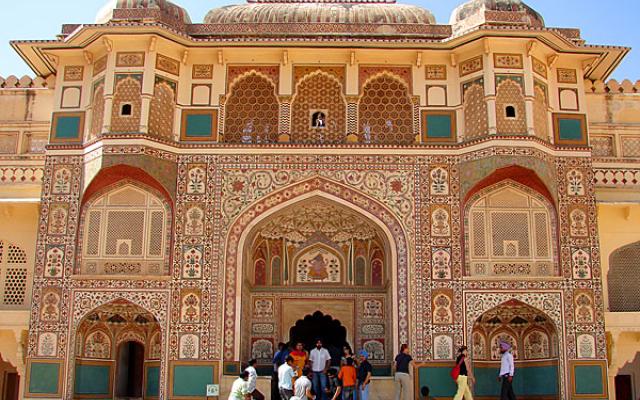Planned by the famous architecture Mr. Vidyadhar Bhattacharya. Jaipur, one of the most beautiful places in the desert land of Rajasthan, is an integral part of India tourism. Popularly known as the Pink City, it is well known around the world for its spectacular forts and magnificent palaces. These reflect the great science of Indian architecture and the glory of Rajputs. Jaipur holds the distinction of being the first planned city of India. The vibrant, colourful costumes, tantalizing and wide variety of food, astounding jewellery captures the attention of tourists making them want to explore the culture and lifestyle of these people.
Famous Historical Monuments To See In Jaipur :
Amber Fort :-
Amer Fort one of the most famous forts of Rajasthan. Amer, originally, was the capital of the state before Jaipur. It is an old fort, built in 1592 by Raja Man Singh. This fort is also very popularly known as the Amer Palace. The Amer Fort was built in red sandstone and marble and the Maotha Lake adds a certain charm to the entire Fort. Though the fort is quite old and may even look so from the outside, it is beautiful on the inside and boasts of various buildings of prominence like the ‘Diwan-i-Aam’, the ‘Sheesh Mahal’ and even the ‘Sukh Mahal’. The Amer Fort has influences of both Hindu and Muslim architecture. This fort also has the ‘Shila Devi’ Temple and the ‘Ganesh Pol’ which is a gate that leads to the private palaces of the kings.
City Palace :-
City Palace is a palace complex in Jaipur, It was the seat of the Maharaja of Jaipur, the head of the Kachwaha Rajput clan. The palace complex, located northeast of the centre of the grid-patterned Jaipur city, incorporates an impressive and vast array of courtyards, gardens and buildings. The palace was built between 1729 and 1732, initially by Sawai Jai Singh II, the ruler of Amber. He planned and built the outer walls, and later additions were made by successive rulers continuing up to the 20th century.
Hawamahal :-
The splendid Rajputana architecture of Hawa Mahal, still speaks the glory of the royal family. However, one can also find a glimpse of Mughal architecture, which is blended perfectly to make it different from others. The literal meaning of Hawa Mahal is Palace of Winds. Hawa Mahal was built by Maharaja Sawai Pratap Singh in 1799. Hawa Mahal is a pyramid-shaped facade with five stories. It has 953 small windows decorated with tiny lattice work. These pink sandstone windows commonly known as “Jharokhas” are constructed in such a style, that it looks like a giant honeycomb.
Jaipur is one of the most attractive destinations in Rajasthan. The variety of attractions in the city makes it a dream destination for tourists. Just as you will find places with historical importance in Jaipur, there are also places in Rajasthan that boasts a lot of natural beauty.
However, the best way to ensure a hassle free and great tour is to get it from a tour operator which has a high level of expertise and experience in this sector. We are a leading tour operator company. Visit our website and book customize tour packages as per your demand. We never compromise in our service.
Here are some our Best tour packages for Jaipur. Choose them any and explore the rich culture of jaipur with us.
Rajasthan Heritage Tour Packages
Rajasthan Luxury Tour Packages
